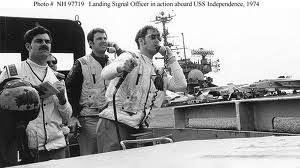Mar.02.2011
by Ed Beakley
2. Landing Signal Officer Perspective
The following comments are from two LSOs who were on the platform “waving” that night, one Bud Langston, from VA-115 the A-6 squadron and the other Pat Moneymaker, from VA-56, the A-7 squadron I was in. Shorter in length than that of A-6 pilot Bruce Kallsen, their comments are telling. The A-6 was bringing aboard hung ordnance creating an unbalanced or asymmetric wing loading, the wind was calm that night meaning the ship had to create its own wind across the deck. Given that the CV landing area is angled off the center line (11 degrees for most carriers but 13 degrees for Schoolboy), the landing was therefore in cross wind conditions. The LSO grade of Kallsen’s landing: (OK) (CDIC). Fair – a little come down in close – so it was not a hard landing.
Of note both Bud and Munt went on in their aviation careers to command squadrons/airwings (Munt was Commanding Officer of the Blue Angels in 1989-90) and retire as Rear Admirals.
From Bud:
I was on the Platform that night as the controlling LSO for the first half of the recovery …. I think it was Hot Dog Brown who took the pickle from me and said he’d take the next few. I had ringside seat for what Mike wrote about.
After talking to Bruce Kallsen this morning it was clear this tragedy has plagued him throughout his life which continues today ….. he helped me recall some details but it was obviously most painful.
It was an A-6A with 2 hung 82′s on the stbd outboard wing …… we were short MER’s so decision was to bring the hung ordnance aboard rather than lose another MER. The ship was making its own wind so a little crosswind, asymmetric max trap with hung ordnance and the stbd axle snapped on impact leaving the strut to catch the #3 or #4 wire. The aircraft rose up on the stbd side as the wire slowed the aircraft and appeared for a moment it was going to flip on its back. Once the wire came off the strut the aircraft continued up the straight deck into CAG’s F-4 which cut the fuselage off just in front of the stabilizer. I remember the tail & stabilizer unit spinning freely beside the Island. Seems to me 2 A-7′s were next and the nose of the A-6 slid in between them collapsing the cockpit on both sides. Seeing the imminent A-7 crash coming up on the right side of the nose the B/N Mike Bixel ejected and was not recovered. The pilot, Bruce Kallsen, rode it out and his leg was injured from the A-7 on the left side of the nose crushing in the port side of the cockpit.
I remember the fire engine driving right into the fire ball and the firefighters with hoses already charged putting water on the flames almost instantaneously. CAG’s F-4 was loose on the flight deck and did a couple rotations, and as I recall went over the side at the crouch of the ship. There was a huge fireball which to my surprise was extinguished very quickly by some amazing heroics of the fire truck guys and hose teams.
Today, I suppose there would be a week stand-down for an incident of that magnitude and loss of life, and several involved would need treatment for something we now call PTSD. But I remember flying a mission the next day because Naval Aviation in that era was solely focused on successfully accomplishing the mission. So aboard USS Midway in October 1972 our crew and Air Wing were clearly living up to that time honored ethos and the battle of her namesake.
From Pat:
… you are asking about a very special night. I was on the platform, but not controlling. It was an overcast night, dark as a JO bunk room. The beach was probably socked in as well, since the Arab (VA-115 Call sign) on the ball was bringing his load of 82’s back aboard. It was an OK pass, I recall, certainly nothing wild. But when the right main mount touched down in the wires, all hell broke loose. The wheel assembly sheared from the strut and the bare stub caught a wire and began a right skid into the folks along the foul line toward the base of the island. From the platform the plane disappeared into the unlit deck forward. There were then two loud reports which were ejection seats firing, the BN being shot into the island. The smell of JP on Skipper Lew (CO of VA-56, his story later) is also a memory, and the wide-eyed stories of MK82s skittering along the deck forward between the parked planes. Oh, the crash truck. What amazing reaction. It was underway nozzle spewing, chasing the A-6 to a stop. Unbelievable.
Next:
Go Back:
1. The Pilot’s Story: Bruce Kallsen VA-115
IV. Bad Night for Schoolboy – And Other Stories of the Carrier

